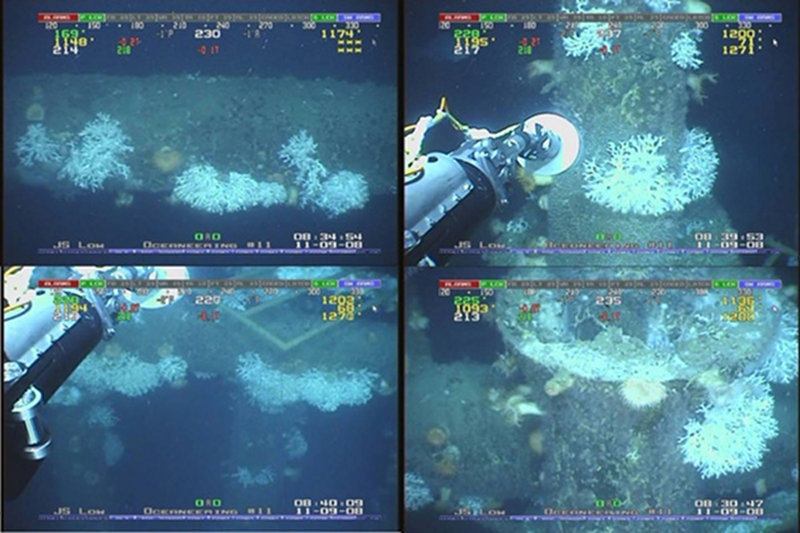
Greg Boland, Biological Oceanographer - Bureau of Ocean Energy Management
July 12 – 23, 2012

Industry inspection video images of corals on the Pompano platform in 2008 at depths of over 300 m. The first observation of Lophelia coral on deep-water Gulf of Mexico platforms was on this same structure in 2003 during a NOAA OER mission. Image courtesy of the Bureau of Ocean Energy Management (BOEM). Download larger version (jpg, 600 KB).
The Lophelia II 2012: Deepwater Platform Corals expedition is the final cruise in a four-year research mission to explore and study deepwater or “cold-water” coral communities in the Gulf of Mexico. This cruise is the first dedicated scientific study of deep-sea corals on actively producing oil and gas platforms.
By visiting deepwater production platforms, scientists hope to gain an understanding of how these structures provide habitat for coral communities. The research will also provide the scientific basis to further refine measures to protect sensitive habitats and contribute to future decisions on how deepwater structures are managed on the Outer Continental Shelf.
Sponsored by the National Oceanographic Partnership Program, the Lophelia II project has brought together scientists to explore and study poorly understood coral communities and shipwrecks in the deep waters of the Gulf of Mexico. The partnership between the Bureau of Ocean Energy Management (BOEM) and NOAA’s Office of Ocean Exploration and Research has also included the U.S. Geological Survey and university scientists.
The development of oil and gas resources has been identified as a potential threat to deep-sea coral habitats. As part of its charge to manage the responsible development of America’s offshore energy, BOEM has funded deepwater coral research in the Gulf for over ten years. Applying scientific results gained through this research to regulatory policy has led to successful adaptive management of these sensitive habitats. For example, as a direct application of the science, BOEM raised the minimum water depth requiring review for all energy development activity and increased the avoidance buffer distances required for separation from drilling discharges.
While one goal of Lophelia II is to increase our understanding of deepwater corals in the Gulf and the communities they support, the project will also have tangible impacts on management of deepwater natural resources.
By Greg Boland, Jay Lunden, and Charles Fisher
Our overall goal for this project is to explore areas of the Gulf of Mexico that may harbor new coral communities and collect data on their habitat characteristics, ecology, physiology, and population structure.
Read moreBy Jay Lunden and Sam Georgian
Not all corals are found on island coasts in shallow seas. In fact, over half of all known coral species are found in deep, dark waters where temperatures range from 4-12° C. For this reason, we call these corals the “cold-water corals,” and they are found all over the world – including the Gulf of Mexico.
Read moreBy Cheryl L. Morrison and D. Katharine Coykendall
Population connectivity is the exchange of individuals among geographically separated populations. For benthic organisms such as corals, connectivity occurs when larvae from one population disperse via ocean currents to another population, where they settle, grow, and reproduce.
Read moreBy Elizabeth Larcom and Charles Fisher
Life is said to move slowly in the deep and this often means organisms have slower growth rates and live longer than their shallow-water counterparts. Living over 2,000 years, deep-water black corals are among the oldest living organisms on Earth.
Read moreBy Amanda W. J. Demopoulos
Deep-sea corals are habitats rich with life, largely a result of the complex habitat that they generate.
Read moreBy Greg Boland
BOEM’s mission is to manage the exploration and development of the offshore energy and marine mineral resources on the 1.76-billion acres of the U.S. Outer Continental Shelf (OCS), while protecting the human, marine, and coastal environments.
Read moreBy Greg Boland
Lophelia coral colonies were first recognized on a deep-water platform during a NOAA Office of Ocean Exploration and Research expedition led by John Reed from the Harbor Branch Oceanographic Institute in 2003. The observations were made on the Pompano structure located in a bottom water depth of 400 meters. Additional images were obtained by industry in 2009 and we know there is a lot of continued growth of deep-sea corals on this platform now.
Read moreBy Marjorie Weisskohl
Since 2004, BOEM and NOAA's Office of Exploration and Research have partnered, with support from USGS, on a series of novel multi-disciplinary ocean research expeditions to explore and characterize poorly known ecosystems in both the Gulf of Mexico and the Atlantic.
Read more